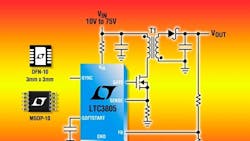Linear Technology’s LTC3805 is a current-mode, programmable frequency PWM controller designed to reduce the size and complexity of flyback power supplies. The device features low start-up current, consuming only 40µA during start-up and 360µA in normal operation. It can operate from an input voltage of 9 V to 75 V when powered through a series resistor. This enables users to have one power supply for both 48 V and 24 V nominal input systems. In addition, it sustains operation down to 4 V after start-up, a necessary feature in automotive applications, where cold cranking may cause the input voltage to dip to 4 V when operating from a nominal 12 V battery.
According to Bruce Haug, Product Marketing Engineer at Linear Technology, "One benefit of low startup current is the ability to use a high-value input resistor and low-value capacitor for quick power supply start-up. Other advantages of low start-up current are a smaller circuit size, low power dissipation and lower cost."
Once the device is operational, a Schottky diode and series resistor can be used to power the LTC3805 from the output in nonisolated designs to further improve the efficiency of the converter. For isolated designs, this can be accomplished through a connection to an additional winding on the primary side of the transformer.
This device contains all the features necessary to design highly efficient single-ended isolated and non-isolated flyback converters rated up to 25 W (see the figure). Because the overcurrent protection threshold voltage is only 100 mV, the device allows use of a low-value, low-power current sense resistor (typically 68 mΩ, for 10W – 48V input designs), further reducing power consumption.
The LTC3805 can regulate output voltages as low as 0.8 V and has an adjustable soft-start function that limits inrush current, reducing output voltage overshoot. Constant frequency operation is maintained down to light loads, resulting is less low frequency noise generation over a wide range of load currents. With adjustable slope compensation, an LTC3805-based power supply achieves fast transient response with minimum output capacitance.
Haug states that development of the IC was initiated in response to customer feedback on the features of the widely accepted previous component, LTC3803, which has a selectable but fixed operating frequency of 200 kHz or 300 kHz, housed in a tiny ThinSOT package. This led to the programmable fixed switching frequency range of 70 kHz to 700 kHz in the LTC3805, which is determined by a programming resistor and can also be synchronized to an external clock using the SYNC pin for noise sensitive applications.
Another important added benefit is the ability to program the turn-on voltage, which is useful in high input voltage applications. For example, the user may want to program the part to turn-on at 15 V (Instead of 9 V, which is the normal UVLO) when using the part in an 18 V to 72 V input voltage application. Programmability is accomplished through a voltage divider on the RUN pin.
Two other significant advantages over the LTC3803 include adjustable overcurrent protection (provided by the OC pin, not shown in the figure, which is separate from the ISENSE pin), and an automatic restart feature, which shuts the converter off during an overcurrent condition and restarts when the overcurrent condition is removed.
The LTC3805 is offered in a 10-Lead 3 mm x 3 mm DFN or 10-lead MSOP package. The 1000-piece price starts at $1.39 each.
